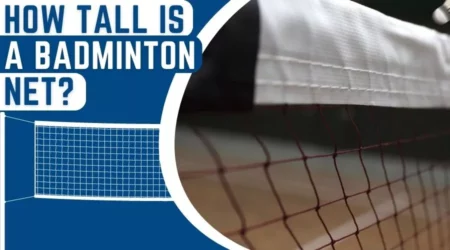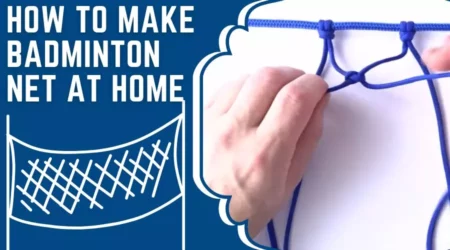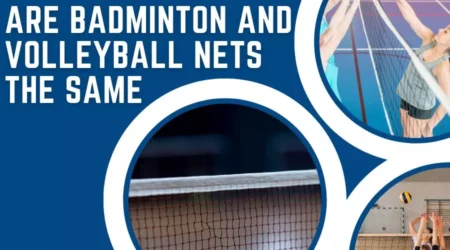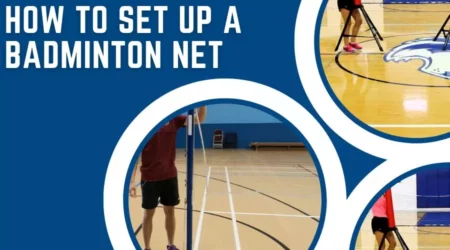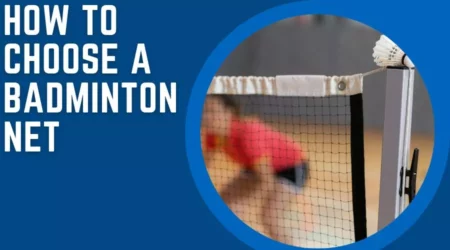Badminton is one of the most popular sports today, with millions of people playing it every day in leisure or competitively.
The game requires players to use a racket and shuttlecock to hit the shuttlecock over the net and into their opponent’s court. But does the noise cross the net in badminton?
According to my point of view Yes, it is possible for a racket to cross the net in badminton – but it’s definitely not a common occurrence!
My Experience
I’ll never forget the time I was playing a particularly intense game of badminton with my best friend.
We were both evenly matched and had been rallying back and forth for what seemed like hours.
As I prepared to serve, I swung my racket with all my might and sent the shuttlecock flying towards my friend’s side of the court.
But to my surprise, the shuttlecock didn’t just clear the net – it actually flew over my friend’s head and landed on the other side of the court! I couldn’t believe it.
I had never seen a racket cross the net in badminton before, and it was an unforgettable moment that I’ll always treasure.
After that, I researched the topic and found out very interesting information about it, so I would like to present my own experiments to answer this question.
I will answer this question by exploring the physics and techniques behind it, as well as the rules and regulations of the sport.
I will also look at how different parties in the sport view this issue and how it affects their experience as a whole.
Get ready to take a closer look at this fascinating topic and discover the answer to the question: Does the racket cross the net in badminton?
Physics of Badminton Strokes
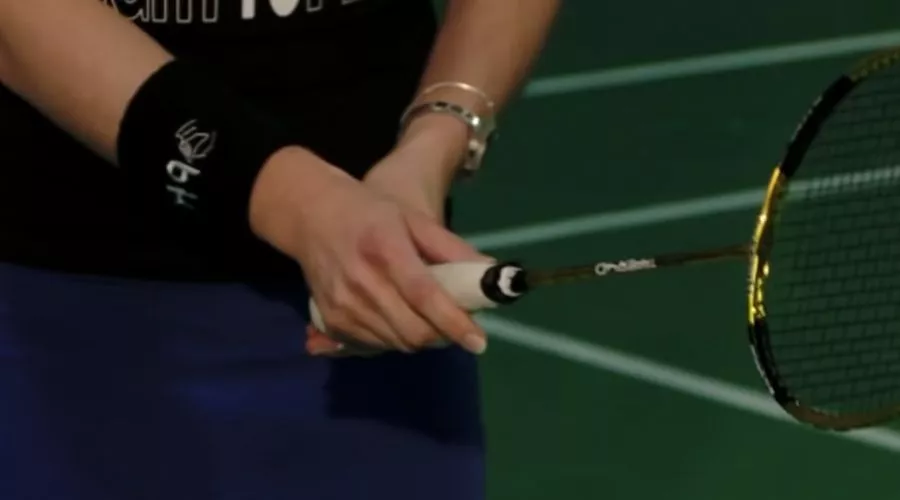
Badminton is played between two people standing on opposite halves of a rectangular court measuring 13.4 × 5.8 meters, with a net 1.5 meters high separating the two halves.
The game is played with a shuttlecock, a spherical projectile with 16 or 18 feathers attached to its top. The shuttlecock is hit back and forth between the two players using a racket, a wooden or carbon-fiber frame with strings wound around it.
The two players rally the shuttlecock by smacking it with their rackets, attempting to hit it over the net and into their opponent’s court.
The player who hits the shuttlecock last after multiple volleys win the point.
Points are also awarded if the opposing player fails to return a shot or hits the shuttlecock outside the court.
A match is won after a player, or a team reaches 11 points, or 21 points, when playing with a full-fledged Badminton game has evolved, with different strokes being invented or modified to suit the changing demands of the game.
However, a few things have remained constant across the years: the speed of the shuttlecock, the length of the racket, and the strength of the player’s grip.
Badminton Rules and Regulations

Badminton is played under the Laws of Badminton, a set of regulations maintained by the Badminton World Federation (BWF).
These laws are modified periodically to consider the changing trends of the sport. The most recent update was in 2018 when a new law was introduced to clarify whether the racket crosses the net in badminton.
The most relevant law for this discussion is Law 16.1, which deals with shuttlecock service, the initial shot of the rally that determines the direction the game will go.
This law states that the shuttlecock must be hit above the server’s head, below the level of the server’s waist, and behind the server’s end of the court.
The shuttlecock must be hit above the head to ensure that it goes high enough for the opposing player to return it, below the waist to prevent the server from hitting it too low, and behind the server’s end to ensure that the shuttlecock is hit first.
The Debate: Does the Racket Cross the Net?

Whether the racket crosses the net in badminton is subjective, and the debate over it has raged for many years.
The laws state that the shuttlecock has to be hit above the server’s head, below the server’s waist, and behind the server’s end of the court to be legal, but they don’t state whether the racket has to cross the net.
This lack of clarity has led to a debate between players, referees, and spectators over whether the racket crosses the net.
The debate has focused on three areas: The discussion of the angle of the racket has been the most heated among players and spectators, with many viewing it as an arbitrary decision that doesn’t have much to do with the rules of the game.
The View from the Players

The players’ view of this debate is simple and straightforward: they want the court to be as big as possible and their opponents to be at a disadvantage.
This is why they advocate for a wide court and a vast racket.
A wide court makes it harder for the opponent to return the shuttlecock and win the rally, while a vast racket makes it harder for the opponent to hit the shuttlecock back to you.
The players also believe the racket should be wide enough to hit the net. Although the shuttlecock has to be hit below the waist, they argue that the racket should be wide enough to hit the net.
This is because the racket should be perpendicular to the net to hit the shuttlecock, and that means it has to cross the net.
In order to make it easier for the spectators to understand this, many players also use a vast racket to hit the shuttlecock below the waist.
This makes it clear to everyone watching the game that the racket is wide enough to hit the net.
The View from the Referees

The referees’ view of this debate is slightly different from that of the players. While the players want the court and the racket to be as comprehensive as possible, the referees wish to the court and the racket to be as narrow as possible.
This is because the referees aren’t playing the game; they are assessing it from an outside perspective and want to make the rules as straightforward as possible.
The referees’ interpretation of the laws is that the shuttlecock must below the waist and the racket has to be below the waist.
They don’t care how vast the racket is as long as it is below the waist.
Their interpretation of the laws also means that the court has to be as narrow as possible, so the players aren’t allowed to stand close to the net.
The View from the Spectators

The spectators’ view of this debate is that the court has to be as comprehensive as possible, with the players standing close to the net.
This view also informs their interpretation of the laws, which means they believe the racket has to be wide enough to hit the net.
Their interpretation of the laws is that the net has to be hit above the waist, below the waist, and behind the server’s end of the court.
While the spectators don’t care how vast the racket is, they do care about its width.
This is because the racket has to be long enough to hit the net, and hitting the net means that the racket has to cross the net.
Techniques and Strategies for Crossing the Net

The simplest way to hit the shuttlecock below the waist is to stand close to the net and use a vast racket to hit the shuttlecock below the waist.
This is what most players do, and it is a legitimate strategy. However, there are other ways to hit the shuttlecock below the waist.
There are two ways to ensure that the racket crosses the net. One is to hit the shuttlecock below the waist and use a wide racket.
The other is to hit the shuttlecock above the waist and use a narrow racket.
The first method is suitable for players who want the game to be more advantageous while the second method is better for players who wish to their opponents to have an easier time.
How Does Crossing the Net Affect the Game?

The debate over whether the racket crosses the net has been raging for years and is unlikely to be resolved anytime soon.
This debate has affected the game in a variety of ways, including:
The debate has also affected spectators, who might have a hard time understanding the laws of the game if they don’t have a proper grasp of the concept of net crossing.
FAQS
Is racket clash a foul in badminton?
In badminton, a foul occurs when the players’ rackets come into contact with each other during a rally. This is known as a ‘racket clash.’ It’s important to note that this rule applies even if the contact is accidental and not intentional.
For example, if two players swing their rackets simultaneously and the rackets come into contact with each other, this is considered a ‘racket clash’ and is an automatic foul. The same applies if one player swings their racket and it contacts the other player’s racket.
A ‘racket clash’ foul also applies if one player’s racket comes into contact with another player’s body or clothing during a rally. Again, even if the connection is accidental, it’s still considered a foul.
Is it a fault when a badminton player’s racquet touches the net when playing?
Yes, it is considered a fault if a badminton player’s racquet touches the net during a game. According to the official rules of badminton, a player shall not touch the net with their person or with their racket at any time during play. Doing so will result in a penalty for the player, and the point will be awarded to the opposing team. Additionally, if a player’s racquet passes over the net and contacts the opponent’s court, it will also be considered a fault. The only exception to this rule is when a shuttlecock is driven into the net. In this case, the shuttlecock is taken out of play, and a “let” is declared, where play is restarted without penalty.
Can a leg cross the net in badminton?
No, a badminton player cannot cross the net during gameplay. Doing so will result in a fault, and the point will be awarded to the other player or team. Crossing the yield is only allowed when changing ends at the end of each game. Players must stay on their side of the court during play and cannot reach over the net to hit the shuttlecock or interfere with their opponent’s shots.

